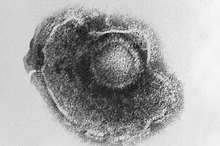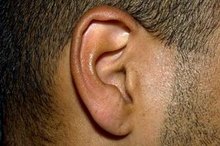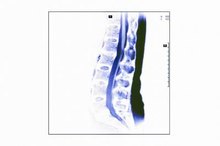On What Parts of Your Body Are Shingles Found?
Shingles is a viral illness that affects a variety of locations throughout the body. It most often causes a painful skin rash on the trunk, abdomen or torso. Less commonly, the rash can be found on the arms or legs. Shingles may also affect the head, face, eyes, mouth or ear. The varicella-zoster virus causes both shingles and chicken pox 2. After recovery from chicken pox, the virus remains inactive in the nervous system, reactivating later in life in one or more parts of the body as shingles.
If you are experiencing serious medical symptoms, seek emergency treatment immediately.
Most Common Locations
Shingles is a painful, usually blistering skin rash typically found on one side of the body, wrapping around the trunk or waist. But it can appear anywhere from the head, arms, chest, abdomen or buttocks down to the feet. Shingles typically begins with a localized sensation of burning or tingling pain lasting 1 to 3 days. The painful area then develops a raised, red rash that wraps around one side of the body in a wide, patchy band. Blisters usually develop and scab before healing. The illness generally lasts between 2 and 5 weeks. The specific location and side of the body affected correspond to the nerve in which the virus has been reactivated. Shingles can appear on more than one location or side of the body, but it most commonly appears in only one area.
- Shingles is a painful, usually blistering skin rash typically found on one side of the body, wrapping around the trunk or waist.
- Shingles can appear on more than one location or side of the body, but it most commonly appears in only one area.
Face and Head Involvement
Early Signs and Symptoms of Eye Shingles
Learn More
When an outbreak of shingles occurs on the head or face, it also typically is found on one side of the scalp, face, mouth or neck or in one eye or ear. As with the rash on the body, the location corresponds to a reactivation of the virus within a nerve. The nerves that supply sensation and motor function to the head and face are called cranial nerves. In addition to causing a painful, blistering red skin rash on the face or head, shingles involving a cranial nerve may cause weakness of the corresponding face muscles. Shingles involving the inside of the mouth or ear may cause ulcers and problems with taste or hearing.
- When an outbreak of shingles occurs on the head or face, it also typically is found on one side of the scalp, face, mouth or neck or in one eye or ear.
- In addition to causing a painful, blistering red skin rash on the face or head, shingles involving a cranial nerve may cause weakness of the corresponding face muscles.
Eye Involvement
About 1 in 7 people with shingles experience eye symptoms. When shingles affects the eye, it can manifest as a skin rash near one eye, redness and pain of the eye itself, difficulty moving the eye or eyelid and even vision loss. Shingles of the eye, called ocular shingles, is a serious condition that requires urgent medical attention.
Systemic Symptoms
Symptoms of Head Shingles
Learn More
Besides the symptoms that correspond to a specific nerve location such as:
- pain
- rash
- ulcers
- face weakness
- vision changes
- taste or hearing problems
- generalized symptoms that affect the whole body often accompany a shingles outbreak
These symptoms usually begin before the localized pain and rash, and they resolve around the same time that the blisters heal.
Related Articles
References
- Pubmed Health: Shingles
- Centers for Disease Control and Prevention: Shingles (Herpes Zoster)
- Centers for Disease Control and Prevention. Shingles (Herpes Zoster) Signs & Symptoms.
- Centers for Disease Control and Prevention. Shingles (Herpes Zoster) Signs & Symptoms.
- John AR, Canaday DH. Herpes Zoster in the Older Adult. Infect Dis Clin North Am. 2017;31(4):811-826. doi: 10.1016/j.idc.2017.07.016
- Yun H, Xie F, Baddley JW, Winthrop K, Saag KG, Curtis JR. Longterm Effectiveness of Herpes Zoster Vaccine among Patients with Autoimmune and Inflammatory Diseases. J Rheumatol. 2017;44(7):1083-1087. doi: 10.3899/jrheum.160685
- Cohen KR, Salbu RL, Frank J, Israel I. Presentation and Management of Herpes Zoster (Shingles) in the Geriatric Population. P T. 2013;38(4): 217-224, 227.
- Galetta KM, Gilden D. Zeroing in on zoster: A tale of many disorders produced by one virus. J Neurol Sci. 2015;358(1-2):38-45. doi: 10.1016/j.jns.2015.10.004
- Blank LJ, Polydefkis MJ, Moore RD, Gebo KA. Herpes zoster among persons living with HIV in the current antiretroviral therapy era. J Acquir Immune Defic Syndr. 2012;61(2):203-7. doi: 10.1097/QAI.0b013e318266cd3c
- Mallick-searle T, Snodgrass B, Brant JM. Postherpetic neuralgia: epidemiology, pathophysiology, and pain management pharmacology. J Multidiscip Healthc. 2016;9:447-454. doi: 10.2147/JMDH.S106340
- Johnson RW, Bouhassira D, Kassianos G, Leplège A, Schmader KE, Weinke T. The impact of herpes zoster and post-herpetic neuralgia on quality-of-life. BMC Med. 2010;8:37. doi: 10.1186/1741-7015-8-37
- Sampathkumar P, Drage LA, Martin DP. Herpes zoster (shingles) and postherpetic neuralgia. Mayo Clin Proc. 2009;84(3):274-80.
- Pereira LB. Impetigo - review. An Bras Dermatol. 2014;89(2):293-9. doi: 10.1590/abd1806-4841.20142283
- Gershon AA, Breuer J, Cohen JI, et al. Varicella zoster virus infection. Nat Rev Dis Primers. 2015;1:15016. doi: 10.1038/nrdp.2015.16
- Naveen KN, Pradeep AV, Kumar JS, Hegde SP, Pai VV, Athanikar SB. Herpes zoster affecting all three divisions of trigeminal nerve in an immunocompetent male: a rare presentation. Indian J Dermatol. 2014;59(4):423. doi: 10.4103/0019-5154.135548
- Opstelten W, Zaal MJ. Managing ophthalmic herpes zoster in primary care. BMJ. 2005;331(7509):147-51. doi: 10.1136/bmj.331.7509.147
- Jeon Y, Lee H. Ramsay Hunt syndrome. J Dent Anesth Pain Med. 2018;18(6):333-337. doi: 10.17245/jdapm.2018.18.6.333
- Kim SH, Choi SM, Kim BC, et al. Risk Factors for Aseptic Meningitis in Herpes Zoster Patients. Ann Dermatol. 2017;29(3):283-287. doi: 10.5021/ad.2017.29.3.283
- Saxena A, Khiangte B, Tiewsoh I, Jajoo UN. Herpes zoster encephalitis presenting as multiple cerebral hemorrhages - a rare presentation: a case report. J Med Case Rep. 2013;7:155. doi: 10.1186/1752-1947-7-155
- Teo HK, Chawla M, Kaushik M. A Rare Complication of Herpes Zoster: Segmental Zoster Paresis. Case Rep Med. 2016;2016:7827140. doi: 10.1155/2016/7827140
- American Academy of Dermatology. Cellulitis: Overview.
- American Academy of Ophthalmology. Herpes Zoster Ophthalmicus.
- Centers for Disease Control and Prevention. Shingles (Herpes Zoster): Clinical Overview. Feb 21, 2018.
- Mayo Clinic. Postherpetic Neuralgia. Sept 16, 2015.
Writer Bio
Dr. Heidi Moawad is a neurologist and author of "Careers Beyond Clinical Medicine," a career guide for physicians. Dr. Moawad teaches human physiology and Global Health at John Carroll University in Cleveland, Ohio







